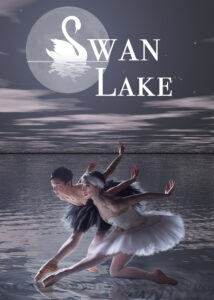Swan Lake

The epitome of classical ballet. A great love story. Tchaikovsky’s scintillating music. Destrooper brings new complexity and choreography to this spellbinding ballet. Prince Siegfried’s love with maiden-turned-white-swan Odette is tested by evil sorcerer Rothbart and his black-swan enchantress, Odile.
BUYER BEWARE
The RMTS is the only authorized seller for Ballet Victoria performances at the Royal Theatre. Any other websites offering tickets for sale are resellers and they are not authorized to sell. If you purchase through a reseller you run the risk of the tickets being invalid, being sold in another currency and being charged above market value. Remember, if you buy from a reseller, the RMTS will not able to troubleshoot or assist you with ticketing issues as the RMTS did not sell the tickets.
Behind the Curtain
TICKETS: Starting at $34.00.
On the RMTS website, subscription package seating is automatically assigned within a selected price category. If you desire specific seats, you must call the RMTS box office at 250-386-6121 to reserve.
VENUE: Royal Theatre, 805 Broughton Street
DATES:
Friday, May 17 at 7:30PM
Saturday, May 18 at 2:00PM
Swan Lake was composed by Russian composer Pyotr Ilyich Tchaikovsky in 1875–76. Despite its initial poor reception by the public, and deemed a failure, it is now one of the most popular ballets of all time and the second most performed after Nutcracker.
The scenario, initially in two acts, was fashioned from Russian and German folk tales and tells the story of Odette, a princess turned into a swan by an evil sorcerer’s curse. The choreographer of the original production was Julius Reisinger. The ballet was premiered by the Bolshoi Ballet on 4 March 1877 at the Bolshoi Theatre in Moscow. Although it is presented in many different versions, most ballet companies base their stagings both choreographically and musically on the 1895 revival of Marius Petipa and Lev Ivanov, first staged for the Imperial Ballet on 15 January 1895, at the Mariinsky Theatre in St. Petersburg. For this revival, Tchaikovsky’s score was revised by the St. Petersburg Imperial Theatre’s chief conductor and composer Riccardo Drigo.
Original production of 1877
The première on 4 March 1877 was given as a benefit performance for the ballerina Pelageya Karpakova (also known as Polina Karpakova), who performed the role of Odette, with première danseur Victor Gillert as Prince Siegfried. Karpakova may also have danced the part Odile, although it is believed the ballet originally called for two different dancers. It is now common practice for the same ballerina to dance both Odette and Odile.
How the Tchaikovsky pas de deux came to life
On 26 April 1877, Anna Sobeshchanskaya made her début as Odette/Odile in Swan Lake, and from the start, she was completely dissatisfied with the ballet. Sobeshchanskaya asked Marius Petipa—Premier Maître de Ballet of the St. Petersburg Imperial Theatres—to choreograph a pas de deux to replace the pas de six in the third act
Petipa created the pas de deux to music by Ludwig Minkus, ballet composer to the St Petersburg Imperial Theatres. The piece was a standard pas de deux classique consisting of a short entrée, the grand adage, a variation for each dancer individually, and a coda.
Tchaikovsky was angered by this change, stating that whether the ballet was good or bad, he alone should be held responsible for its music. He agreed to compose a new pas de deux, but soon a problem arose: Sobeshchanskaya wanted to retain Petipa’s choreography. Tchaikovsky agreed to compose a pas de deux that would match to such a degree, the ballerina would not even be required to rehearse. Sobeshchanskaya was so pleased with Tchaikovsky’s new music, she requested he compose an additional variation, which he did.
The “story” of Swan Lake
Tchaikovsky’s magical ballet tells the story of the doomed love of Prince Siegfried and Princess Odette. Prince Siegfried goes out hunting one night and chases a group of swans – one of them transforms into a young woman, Odette, who explains that she and her companions were turned into swans by the evil Baron Von Rothbart.
The spell can only be broken if someone who has never loved before swears an oath of undying love and promises to marry her. The Prince declares his love to Odette and promises to be loyal forever.
At a grand reception at the palace, the Prince must choose a bride – but he can think only of Odette. Suddenly a fanfare announces the arrival of two guests – it is Odette! The prince dances with her and asks for her hand in marriage.
But it’s not Odette – the mystery woman is the daughter of the evil von Rothbart, Odile. Odette has witnessed the whole scene. Too late, Siegfried realises his mistake.
Siegfried follows Odette to the lake and begs her forgiveness. She says she forgives him but nothing can change the fact he broke his vow. They decide to die together. The lovers throw themselves into the lake.
3 INTERESTING FACTS ABOUT SWAN LAKE YOU MAY NOT KNOW.
1. The première was regarded as a failure. Critics dismissed Tchaikovsky’s music as too noisy. Dancers disliked the fast-paced score. It wasn’t until after Tchaikovsky’s death that French choreographer, Marius Petipa, revived the iconic ballet.
2. Swan Lake is famous for the 32 fouettés en tournant in Act 3, an incredible athletic feat. These fouettés are danced at the end of the “Black Swan” pas de deux by the ballerina playing Odile. The pas was an afterthought of Tchaikovsky’s. It was not included in the original production.
3. During this challenging production, ballerinas may use up to three pairs of pointe shoes during one performance of Swan Lake.